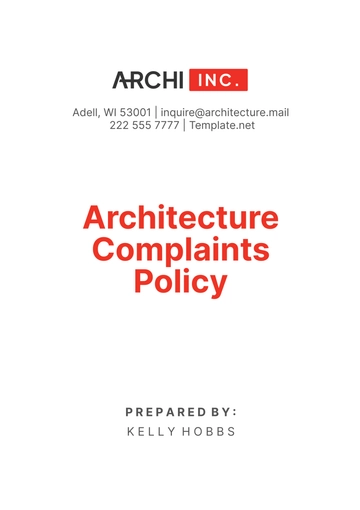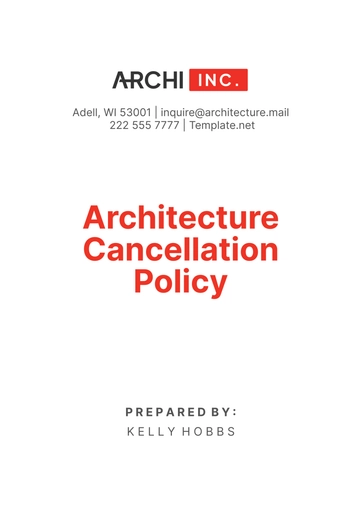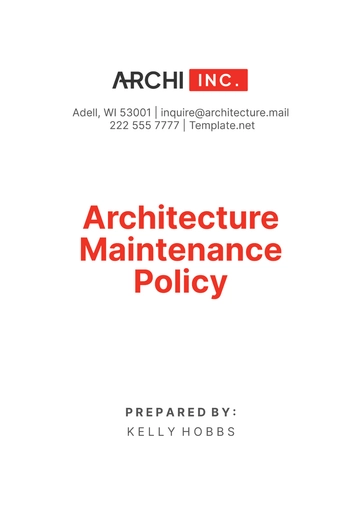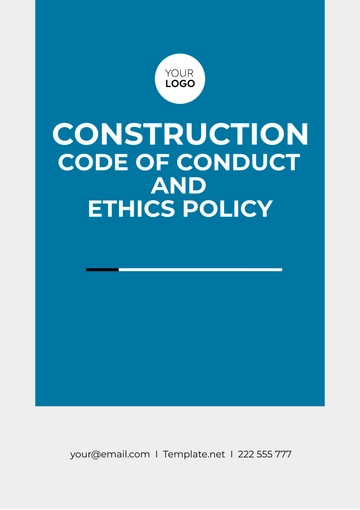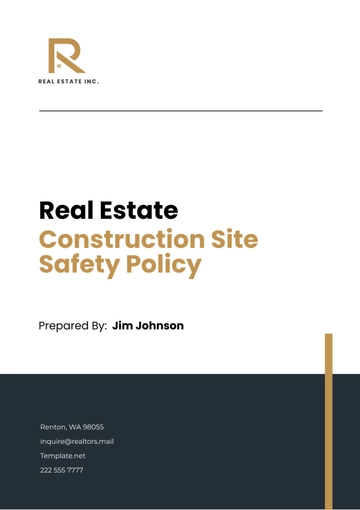Free Real Estate Construction Site Safety Policy
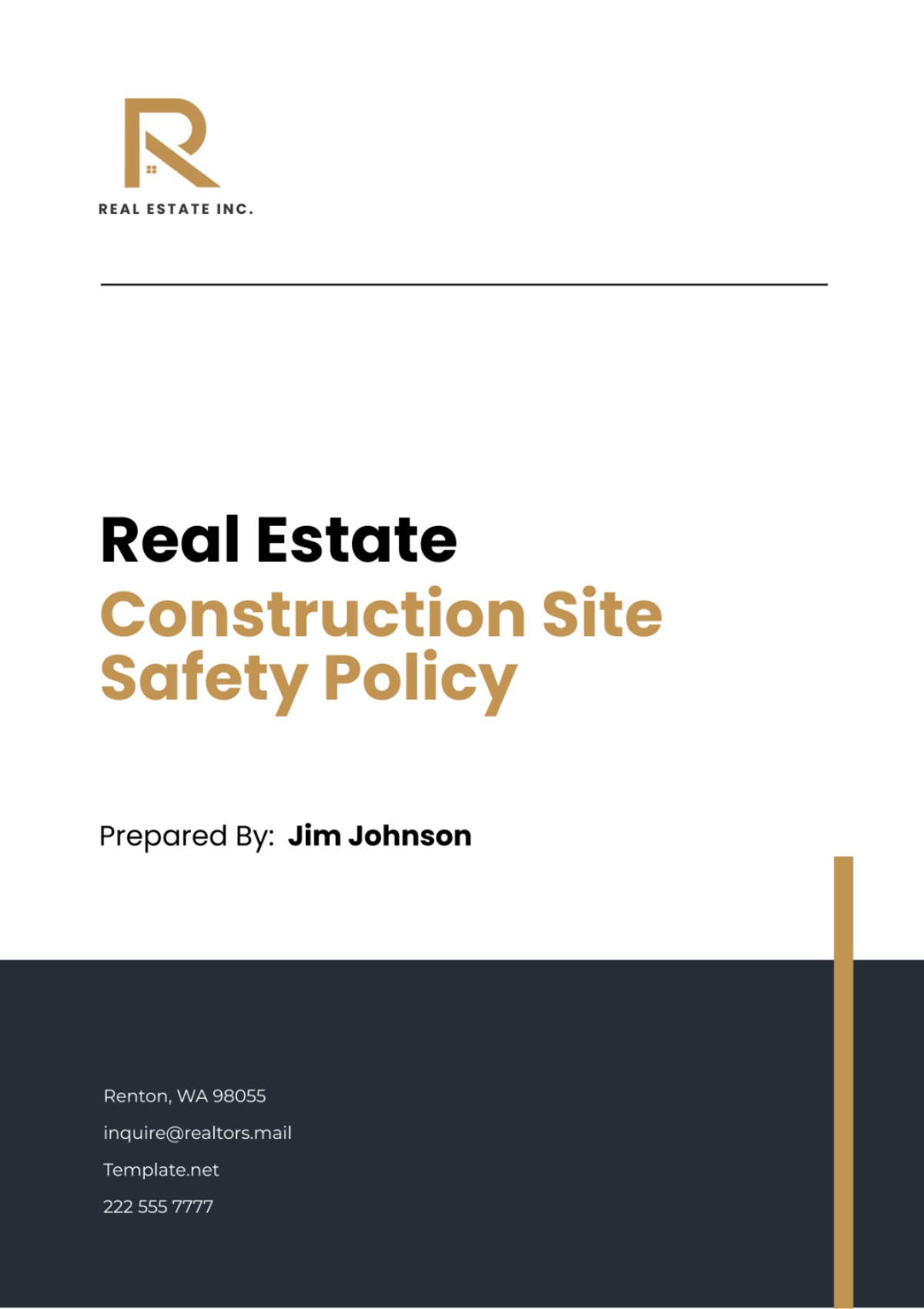
I. Introduction
A. Purpose
[Your Company Name] is dedicated to ensuring the safety and well-being of all individuals involved in construction activities at our real estate development sites. This Construction Site Safety Policy is established to ensure a safe working environment, compliance with regulations and standards, and the promotion of a culture of safety.
B. Scope
This policy applies to all personnel engaged in construction activities at [Your Company Name] real estate development sites, including employees, contractors, visitors, and any other individuals present at the construction site.
II. Responsibilities
A. Management Responsibilities
[Your Company Name] management is responsible for providing leadership and support, allocating resources for safety measures, ensuring compliance with safety regulations, conducting regular safety inspections and audits, and investigating and addressing safety concerns promptly.
B. Employee Responsibilities
All employees are responsible for following safety procedures and protocols, participating in safety training programs, reporting any unsafe conditions or incidents, using personal protective equipment (PPE), and cooperating with safety audits and inspections.
III. Hazard Identification and Control
A. Risk Assessment
Prior to commencing any construction activities, a comprehensive risk assessment will be conducted to identify potential hazards. This assessment will involve:
Identifying potential hazards associated with the construction site, including but not limited to falls, electrical hazards, chemical exposures, and equipment-related risks.
Evaluating the likelihood and severity of identified hazards.
Determining appropriate control measures to mitigate the identified risks.
B. Hazard Control Measures
Appropriate control measures will be implemented to mitigate identified hazards. These measures may include:
Engineering controls: Implementing physical changes to the work environment or equipment to minimize hazards. For example, installing guardrails to prevent falls or using ventilation systems to control chemical exposures.
Administrative controls: Establishing procedures and policies to reduce exposure to hazards. This may include scheduling work to minimize exposure to hazardous conditions or implementing job rotation to reduce repetitive strain injuries.
Personal protective equipment (PPE): Providing workers with necessary PPE, such as hard hats, safety goggles, gloves, and respiratory protection, to protect against specific hazards.
IV. Safety Training
A. General Training
All individuals working at [Your Company Name] construction sites will receive general safety training covering:
Hazard recognition: Identifying common construction hazards and understanding their potential risks.
Emergency procedures: Knowing how to respond to emergencies such as fires, medical incidents, and evacuations.
Safe work practices: Learning proper techniques for lifting, handling materials, operating equipment, and working at heights.
Proper use of equipment and machinery: Understanding the safe operation and maintenance of tools, machinery, and vehicles used on-site.
B. Specialized Training
Employees involved in specific tasks or using specialized equipment will receive additional training as necessary. This may include:
Training on specialized equipment: Providing instruction on the safe operation of equipment such as cranes, forklifts, and scaffolding systems.
Hazard-specific training: Offering training tailored to the hazards associated with specific tasks or work environments, such as confined space entry or working with hazardous chemicals.
Certification programs: Ensuring that workers are properly certified and trained to perform specialized tasks, such as welding or operating heavy machinery.
V. Emergency Preparedness
A. Emergency Response Plan
[Your Company Name] will develop and maintain an emergency response plan outlining procedures for:
Evacuation: Establishing evacuation routes and assembly points in the event of fire, natural disasters, or other emergencies requiring evacuation.
Medical emergencies: Providing guidelines for responding to injuries, illnesses, and medical emergencies on-site, including first aid procedures and emergency medical contact information.
Fire incidents: Outlining procedures for reporting fires, activating fire alarms, and using fire extinguishers, as well as evacuation protocols.
Natural disasters: Implementing protocols for responding to severe weather events, earthquakes, floods, or other natural disasters to ensure the safety of personnel and minimize property damage.
B. Emergency Contact Information
Contact information for emergency services, management personnel, and medical facilities will be prominently displayed at construction sites. This includes:
Emergency services: Providing phone numbers for local emergency services, including police, fire department, and ambulance services.
Management personnel: Designating key personnel responsible for coordinating emergency response efforts and providing their contact information.
Medical facilities: Listing nearby hospitals, urgent care centers, and medical clinics, along with their addresses and phone numbers for quick reference in case of medical emergencies.
VI. Incident Reporting and Investigation
A. Reporting Procedures
All incidents, including near misses, injuries, and property damage, must be reported to management immediately. Reporting procedures include:
Immediate notification: Instructing personnel to report incidents as soon as they occur to ensure prompt response and investigation.
Reporting channels: Providing multiple channels for reporting incidents, such as direct communication with supervisors, designated safety officers, or using incident reporting forms or apps.
Anonymous reporting: Offering the option for individuals to report incidents anonymously to encourage reporting without fear of retaliation.
B. Investigation Process
An investigation will be conducted for all reported incidents to determine root causes and prevent recurrence. The investigation process includes:
Gathering information: Collecting relevant data, witness statements, and evidence related to the incident.
Root cause analysis: Identifying underlying factors contributing to the incident, such as equipment malfunctions, human error, or inadequate safety procedures.
Corrective actions: Implementing corrective measures to address identified hazards and prevent similar incidents from occurring in the future.
Documentation: Documenting investigation findings, corrective actions taken, and lessons learned to improve safety procedures and prevent recurrence.
VII. Safety Inspections and Audits
A. Regular Inspections
Routine inspections will be conducted to identify potential hazards and ensure compliance with safety policies. Key aspects of regular inspections include:
Frequency: Inspections will be conducted on a regular basis, with specific intervals determined based on the complexity of the construction site, project phase, and regulatory requirements.
Inspection checklist: Utilizing a comprehensive checklist covering various safety aspects, including site conditions, equipment maintenance, housekeeping, and adherence to safety procedures.
Inspection teams: Assigning trained personnel or safety officers to conduct inspections, ensuring thorough assessments of all areas and activities at the construction site.
Documentation: Recording inspection findings, including identified hazards, corrective actions taken, and recommendations for improvement, to track compliance and monitor safety performance over time.
B. Audits
Periodic audits will be performed to evaluate the effectiveness of safety programs and identify areas for improvement. Audits will include:
Scope: Audits will assess overall compliance with safety policies, procedures, and regulatory requirements, focusing on key areas such as hazard control measures, training effectiveness, and emergency preparedness.
Audit criteria: Establishing clear criteria and benchmarks for evaluating safety performance, based on industry standards, best practices, and regulatory guidelines.
Independent review: Conducting audits by qualified personnel or third-party auditors independent of day-to-day operations to ensure objectivity and thoroughness in assessing safety practices.
Action plans: Developing action plans based on audit findings to address identified deficiencies, implement corrective measures, and continuously improve safety performance.
VIII. Safety Communication
A. Communication Channels
[Your Company Name] will establish clear channels for communicating safety information to all stakeholders. Effective communication channels include:
Safety meetings: Conducting regular safety meetings to discuss hazards, safety procedures, incident reports, and updates on safety initiatives.
Safety bulletins: Issuing safety bulletins or newsletters to disseminate important safety information, alerts, reminders, and best practices.
Posters and signage: Displaying visual aids, safety posters, and signage at prominent locations throughout the construction site to reinforce safety messages and promote awareness.
Digital platforms: Utilizing digital platforms, such as email, intranet portals, and mobile applications, to distribute safety-related documents, training materials, and updates to employees and contractors.
B. Safety Promotion
Promotional activities will be organized to raise awareness of safety practices and encourage active participation in safety initiatives. Safety promotion efforts may include:
Recognition programs: Acknowledging and rewarding individuals or teams for outstanding safety performance, participation in safety training, or proactive hazard reporting.
Safety campaigns: Launching targeted safety campaigns or initiatives focusing on specific hazards, themes, or seasonal safety topics to engage employees and reinforce safety culture.
Training workshops: Offering interactive workshops, demonstrations, or toolbox talks on relevant safety topics, providing practical guidance and hands-on learning experiences for workers.
Peer-to-peer engagement: Encouraging peer-to-peer communication and mentoring to share safety experiences, lessons learned, and best practices among workers at all levels of the organization.
IX. Record Keeping
A. Documentation
[Your Company Name] is committed to maintaining accurate records of safety-related activities for regulatory compliance and continuous improvement. Key aspects of record keeping include:
Safety training records: Documenting details of safety training sessions attended by employees, contractors, and visitors, including topics covered, dates, and participant signatures.
Inspection reports: Recording findings from routine safety inspections, including identified hazards, corrective actions taken, and follow-up actions required.
Incident reports: Documenting all reported incidents, near misses, injuries, property damage, and their corresponding investigations, including root cause analysis and corrective measures.
Safety audits: Maintaining records of safety audit findings, action plans, and follow-up actions to track progress and ensure ongoing compliance with safety standards.
Compliance documentation: Keeping documentation of regulatory requirements, permits, licenses, and certifications relevant to construction site safety, ensuring legal compliance and adherence to standards.
B. Storage and Accessibility
All safety-related records will be stored securely and made accessible to authorized personnel as needed. Storage and accessibility measures include:
Electronic storage: Utilizing electronic databases, document management systems, or cloud-based platforms to store safety records securely, ensuring easy access, retrieval, and backup.
Physical storage: Maintaining hard copies of essential safety documents, such as incident reports and training records, in designated filing systems or secure storage facilities.
Access controls: Implementing access controls and permissions to restrict access to sensitive safety records, ensuring confidentiality and data security.
Retention periods: Establishing retention periods for safety records in accordance with regulatory requirements and organizational policies, retaining records for the required duration before disposal or archiving.
X. Compliance
A. Regulatory Compliance
[Your Company Name] is dedicated to complying with all relevant local, state, and federal regulations governing construction site safety. Compliance measures include:
Stay informed: Monitoring and staying abreast of changes to safety regulations, codes, standards, and industry best practices applicable to construction activities.
Regulatory assessments: Conducting periodic assessments to ensure compliance with applicable safety regulations and standards, identifying areas for improvement and implementing corrective actions as necessary.
Regulatory reporting: Submitting required reports, notifications, permits, and certifications to regulatory authorities in a timely manner, demonstrating compliance with legal requirements and obligations.
B. Standards Adherence
[Your Company Name] is committed to adhering to industry best practices and standards to enhance construction site safety. Adherence to standards includes:
Industry guidelines: Following established industry guidelines, such as those provided by the Occupational Safety and Health Administration (OSHA), National Institute for Occupational Safety and Health (NIOSH), and relevant trade associations.
Continuous improvement: Continuously evaluating and benchmarking safety practices against industry standards, seeking opportunities for improvement, and implementing proactive measures to enhance safety performance.
Participation in industry initiatives: Engaging in industry forums, working groups, and collaborative initiatives focused on promoting construction site safety, sharing knowledge, and driving collective improvement efforts.
XI. Review and Revision
A. Policy Review
This Construction Site Safety Policy will undergo periodic reviews to ensure its effectiveness and relevance in promoting a safe working environment. Key aspects of policy review include:
Frequency: The policy will be reviewed at regular intervals, with the frequency determined based on changes in regulations, industry standards, and organizational needs.
Stakeholder input: Soliciting feedback and input from relevant stakeholders, including employees, management, safety professionals, and regulatory authorities, to identify areas for improvement.
Compliance assessment: Assessing the policy's alignment with current regulatory requirements and industry best practices to ensure continued compliance and effectiveness.
Performance evaluation: Evaluating the policy's performance in achieving safety objectives, reducing incidents, and fostering a culture of safety within the organization.
B. Revision Process
Any necessary revisions to the policy will be made in consultation with relevant stakeholders and communicated effectively to all personnel. The revision process includes:
Identification of changes: Identifying changes in regulations, standards, organizational needs, and lessons learned from incidents or near misses that necessitate updates to the policy.
Stakeholder engagement: Involving key stakeholders, including employees, safety committees, management, and regulatory authorities, in the revision process to gather input and ensure buy-in.
Documented updates: Documenting all revisions to the policy, including the rationale behind each change, and maintaining a clear version control system to track updates and ensure transparency.
Communication and training: Communicating revised policies to all affected parties through training sessions, safety meetings, and distribution of updated documents, ensuring awareness and understanding of changes.
XII. Conclusion
A. Commitment to Safety
[Your Company Name] reaffirms its commitment to fostering a culture of safety and continuous improvement in all construction activities. By adhering to this Construction Site Safety Policy and working together to identify and mitigate risks, we will create a safer working environment for everyone involved.
B. Contact Information
For questions or concerns regarding this policy, please contact [Your Name] at [Your Company Email] or [Your Company Number]. Your feedback is valuable in helping us maintain the highest standards of safety at our construction sites.
- 100% Customizable, free editor
- Access 1 Million+ Templates, photo’s & graphics
- Download or share as a template
- Click and replace photos, graphics, text, backgrounds
- Resize, crop, AI write & more
- Access advanced editor
Prioritize safety on construction sites with the Real Estate Construction Site Safety Policy Template from Template.net. This editable and customizable policy establishes guidelines for maintaining a secure work environment, minimizing risks, and ensuring compliance with regulations. Tailor it effortlessly using our Ai Editor Tool for personalized safety protocols. Strengthen safety measures and protect personnel with this essential template.
You may also like
- HR Policy
- Restaurant Policy
- Company Policy
- Accounting Policies and Procedures
- Website Policy
- Privacy Policy
- Safety Policy
- School Policy
- IT and Software Policy
- Law Firm Policy
- Construction Policy
- Interior Design Policy
- Travel Agency Policy
- Education Academic Policy
- Security Policy
- Real Estate Policy
- Expense Policy
- Software Policy
